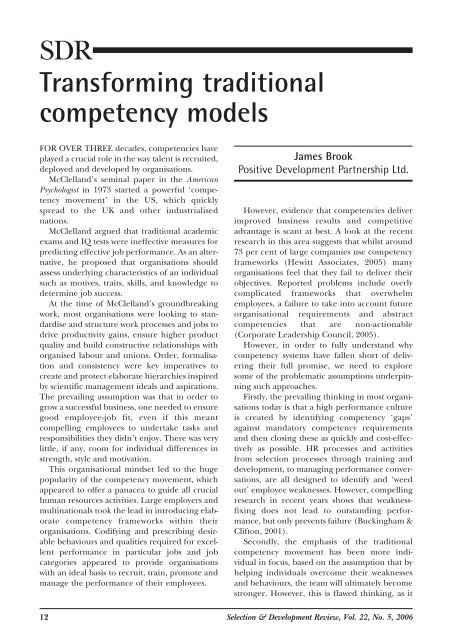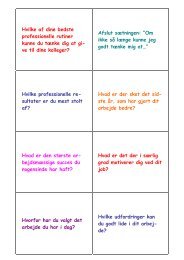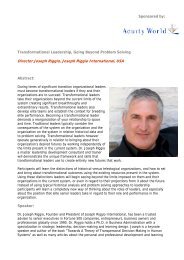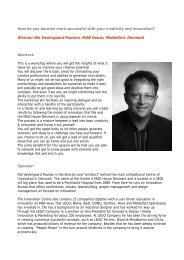SDR Transforming traditional competency models
SDR Transforming traditional competency models
SDR Transforming traditional competency models
You also want an ePaper? Increase the reach of your titles
YUMPU automatically turns print PDFs into web optimized ePapers that Google loves.
<strong>SDR</strong><strong>Transforming</strong> <strong>traditional</strong><strong>competency</strong> <strong>models</strong>FOR OVER THREE decades, competencies haveplayed a crucial role in the way talent is recruited,deployed and developed by organisations.McClelland’s seminal paper in the AmericanPsychologist in 1973 started a powerful ‘<strong>competency</strong>movement’ in the US, which quicklyspread to the UK and other industrialisednations.McClelland argued that <strong>traditional</strong> academicexams and IQ tests were ineffective measures forpredicting effective job performance. As an alternative,he proposed that organisations shouldassess underlying characteristics of an individualsuch as motives, traits, skills, and knowledge todetermine job success.At the time of McClelland’s groundbreakingwork, most organisations were looking to standardiseand structure work processes and jobs todrive productivity gains, ensure higher productquality and build constructive relationships withorganised labour and unions. Order, formalisationand consistency were key imperatives tocreate and protect elaborate hierarchies inspiredby scientific management ideals and aspirations.The prevailing assumption was that in order togrow a successful business, one needed to ensuregood employee-job fit, even if this meantcompelling employees to undertake tasks andresponsibilities they didn’t enjoy. There was verylittle, if any, room for individual differences instrength, style and motivation.This organisational mindset led to the hugepopularity of the <strong>competency</strong> movement, whichappeared to offer a panacea to guide all crucialhuman resources activities. Large employers andmultinationals took the lead in introducing elaborate<strong>competency</strong> frameworks within theirorganisations. Codifying and prescribing desirablebehaviours and qualities required for excellentperformance in particular jobs and jobcategories appeared to provide organisationswith an ideal basis to recruit, train, promote andmanage the performance of their employees.James BrookPositive Development Partnership Ltd.However, evidence that competencies deliverimproved business results and competitiveadvantage is scant at best. A look at the recentresearch in this area suggests that whilst around73 per cent of large companies use <strong>competency</strong>frameworks (Hewitt Associates, 2005) manyorganisations feel that they fail to deliver theirobjectives. Reported problems include overlycomplicated frameworks that overwhelmemployees, a failure to take into account futureorganisational requirements and abstractcompetencies that are non-actionable(Corporate Leadership Council, 2005).However, in order to fully understand why<strong>competency</strong> systems have fallen short of deliveringtheir full promise, we need to exploresome of the problematic assumptions underpinningsuch approaches.Firstly, the prevailing thinking in most organisationstoday is that a high performance cultureis created by identifying <strong>competency</strong> ‘gaps’against mandatory <strong>competency</strong> requirementsand then closing these as quickly and cost-effectivelyas possible. HR processes and activitiesfrom selection processes through training anddevelopment, to managing performance conversations,are all designed to identify and ‘weedout’ employee weaknesses. However, compellingresearch in recent years shows that weaknessfixingdoes not lead to outstanding performance,but only prevents failure (Buckingham &Clifton, 2001).Secondly, the emphasis of the <strong>traditional</strong><strong>competency</strong> movement has been more individualin focus, based on the assumption that byhelping individuals overcome their weaknessesand behaviours, the team will ultimately becomestronger. However, this is flawed thinking, as it12 Selection & Development Review, Vol. 22, No. 5, 2006
ignores powerful interaction effects that occurbetween individuals in a team when complementarystrengths and capabilities areharnessed. What organisations need to betterunderstand is why it is that some individualsappear to benefit from each others’ strengths ina team environment while other combinationsseem to undermine the energy, strengths andmotivation of team members. It is only throughunderstanding these interaction effects that wecan build engaged and productive workforces.Finally, <strong>traditional</strong> approaches assume thatjobs are relatively static and employees benefitfrom having a prescribed set of competencies fortheir training and career progression. Detailedcareer paths are often mapped out foremployees, with elaborate <strong>competency</strong> developmentdirectories and training programmestargeted at ‘grooming’ employees in skills andbehavioural areas where they are assessed to be‘falling short’. Euphemisms for employee weaknessessuch as ‘development opportunities’ and‘improvement areas’ abound in such environments.However, the operating environment andemployee expectations in most organisationshave changed beyond recognition. Mostemployees no longer prioritise job security andsteady career progression in exchange for theirservices. Rather, they want to be recognised asindividuals with unique skills, behaviours andother qualities they bring to the organisation.They also want interesting and challenging workwhich allows them to use these skills and qualitiesas frequently as possible. In short, they wantto use their distinctive strengths and feel a senseof fulfilment when they leave the office at theend of each day.What we now need is different set of assumptions,tools and practices from management andhuman resources. Recruitment activities need tofocus on attracting and identifying people withdistinctive strengths that will help challenge thestatus quo and create lasting value. This goes waybeyond ‘shoehorning’ people neatly into jobs,providing them with skills training andrewarding them for doing a good job. Talentdevelopment and deployment systems need tobe designed to help people optimise theirstrengths through building awareness of whichactivities they find energising and have a naturaltalent for and how they can deploy thesestrengths more fully at work.Performance conversations need to be refocusedaround employees’ strengths rather thanon their weaknesses. This doesn’t mean ignoringweaknesses, as this would be just as detrimentaland demotivating to employees as only focusingon shortcomings. It simply means putting a greatdeal more emphasis on strengths and achievementsand helping individuals understand howthey can deploy their strengths more effectivelyto achieve desired outcomes. It is also importantthat these conversations help employees maketheir weaknesses less relevant by finding creativeways to manage around or mitigate these. Thislends itself to constructive dialogue between themanager and their employees around creativeapproaches for managing weaknesses includingcomplementary co-worker partnering, delegation,reframing, employing new technologies,bringing in resource support from outside theteam or organisation, etc.We are not suggesting that organisations withwell-established <strong>competency</strong> frameworks shouldabandon these. If appropriately used, competenciescan provide a strong foundation for effectivehuman resources decisions and practices.However, this will require a much more flexibleand realistic application of competencies whichrecognises that like professional athletes, mostindividuals posses only a few distinctivestrengths. They cannot be equally good at thelong ‘wish list’ of behaviours and skills typicallydemanded by organisations.Changing assumptions about how people aremanaged needs to start at the top, with courageousand decisive leaders who are prepared tochallenge their own people managementassumptions and approaches based on manyyears of experience and conditioning. In orderto bring about an environment where authenticexpression and strengths can be optimised,leaders need to model the way, promoting achallenging and appreciative work environmentthat encourages strengths deployment,creativity, open-mindedness and risk-taking inline with the organisation’s overall purpose andgoals. To do this, they need to move beyond<strong>traditional</strong> personnel management principles ofconsistency, compliance, risk-aversion andorder, hallmarks of a bygone era.Selection & Development Review, Vol. 22, No. 5, 2006 13
ReferencesBuckingham, M. & Clifton, D.O. (2001).Now discover your strengths. London: Simon &Schuster UK Ltd.Corporate Leadership Council (2005). LiteratureKey Findings: The Advantages and Disadvantagesof Competency Models. Downloaded August,2005, from:www.corporateleadershipcouncil.comHewitt Associates (2005). Research highlights:How the top 20 companies grow greatleaders. Downloaded February, 2006, from:http://www.hewittassociates.com/_MetaBasicCMAssetCache_/Assets/Articles/top_companies_2005.pdfMcClelland, D.C. (1973). Testing forcompetence rather than intelligence.American Psychologist, 28, 1–14.James Brook, M.Soc.Sci, MBA, is founder andmanaging director of Positive DevelopmentPartnership Ltd., a management consulting firmspecialising in strengths-focused leadershipdevelopment, coaching and talent managementsolutions. He has 15 years’ experience in leadershipdevelopment and talent management,having worked in consulting and a variety ofcorporate roles.James specialises in strengths-focused solutionsto talent development and performanceimprovement, building authentic, inspirationalleadership, executive and cross-culturalcoaching, and designing innovative assessmentapproaches to identify, retain and develop talent.WHAT ARE YOU DOING?Why don’t you tell us? The <strong>SDR</strong> editorial team are interested in hearingfrom anyone researching or practising in the fields of assessment anddevelopment. In particular, we are interested in receiving articles and casestudies relating to:★ The evaluation of assessment and development processes;★ Improvements in assessment centre design;★ Improvements in selection tools and methodologies;★ Leadership development and talent management processes;★ Current practices in coaching and personal development.If you are involved in new, interesting or challenging work/research in anyof these, or similar areas, please get in touch with the editors(contact Philippa Hain at philippa.hain@ntlworld.com).Go on! Make it one of your resolutions for 2007!14 Selection & Development Review, Vol. 22, No. 5, 2006






